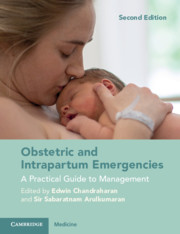Book contents
- Obstetric and Intrapartum Emergencies
- Obstetric and Intrapartum Emergencies
- Copyright page
- Contents
- Contributors
- Preface
- Preface to the First Edition
- Acknowledgements
- Section 1 General Principles
- Section 2 Algorithms for Management of the Top Five ‘Direct Killers’
- Section 3 Intrapartum Emergencies
- Section 4 Postpartum Emergencies
- Section 5 Medical and Surgical Emergencies During Pregnancy
- Section 6 Anaesthetic Emergencies During Pregnancy
- Section 7 Neonatal Emergencies and the Management of Immediate Neonatal Problems
- Section 8 Management of Anticipated and Non-anticipated Emergencies in Pregnancy
- Chapter 37 Placenta Accreta Spectrum Disorders (Abnormal Invasion of the Placenta)
- Chapter 38 Peri- and Postmortem Caesarean Section
- Chapter 39 Management of Established Preterm Labour and Rescue Cerclage
- Chapter 40 Failed Operative Vaginal Delivery
- Section 9 Setting-Up Skills and Drills Training in Maternity Services and Reducing Avoidable Harm
- Index
- References
Chapter 40 - Failed Operative Vaginal Delivery
Minimising Maternal and Fetal Morbidity
from Section 8 - Management of Anticipated and Non-anticipated Emergencies in Pregnancy
Published online by Cambridge University Press: 06 May 2021
- Obstetric and Intrapartum Emergencies
- Obstetric and Intrapartum Emergencies
- Copyright page
- Contents
- Contributors
- Preface
- Preface to the First Edition
- Acknowledgements
- Section 1 General Principles
- Section 2 Algorithms for Management of the Top Five ‘Direct Killers’
- Section 3 Intrapartum Emergencies
- Section 4 Postpartum Emergencies
- Section 5 Medical and Surgical Emergencies During Pregnancy
- Section 6 Anaesthetic Emergencies During Pregnancy
- Section 7 Neonatal Emergencies and the Management of Immediate Neonatal Problems
- Section 8 Management of Anticipated and Non-anticipated Emergencies in Pregnancy
- Chapter 37 Placenta Accreta Spectrum Disorders (Abnormal Invasion of the Placenta)
- Chapter 38 Peri- and Postmortem Caesarean Section
- Chapter 39 Management of Established Preterm Labour and Rescue Cerclage
- Chapter 40 Failed Operative Vaginal Delivery
- Section 9 Setting-Up Skills and Drills Training in Maternity Services and Reducing Avoidable Harm
- Index
- References
Summary
Operative vaginal birth rate has been stable in the United Kingdom at about 10%–13% [3, 4]. The caesarean section at full dilation as an alternative approach to instrument delivery has a high maternal and neonatal morbidity, but failed instrument vaginal deliveries (FID), which lead to caesarean sections, are associated with potentially serious maternal and fetal complications such as angular tears, postpartum haemorrhage, difficulty in delivery of the fetal head, fetal ischaemic-hypoxic injuries, birth trauma and perinatal deaths. Therefore, it is important to identify factors which can help to predict successful operative vaginal delivery.
There are various established risk factors which increase the chances of instrument delivery, including advanced maternal age, high body mass index (BMI; >30), high birth weight (>4.0 kg) and epidural analgesia.
- Type
- Chapter
- Information
- Obstetric and Intrapartum EmergenciesA Practical Guide to Management, pp. 292 - 296Publisher: Cambridge University PressPrint publication year: 2021



